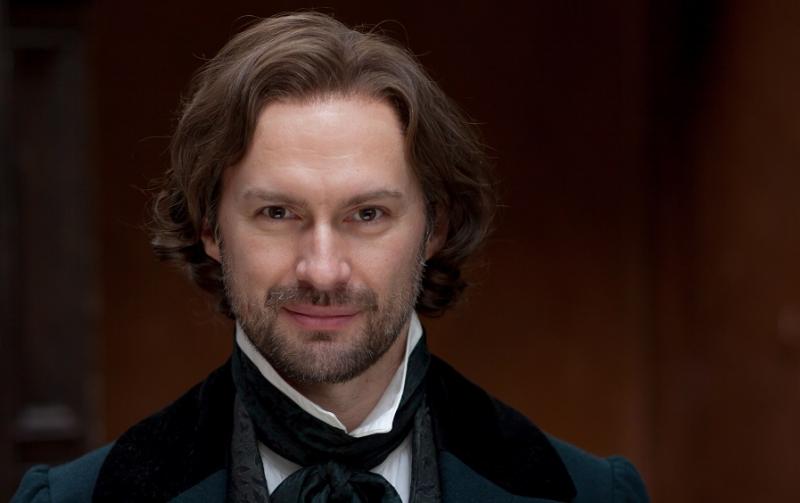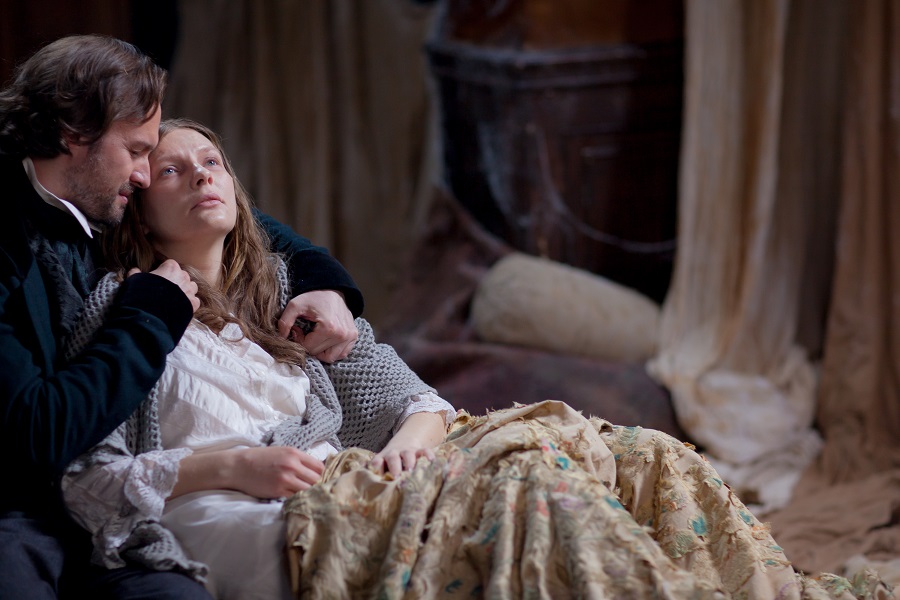First Person: Once More With Feeling | reviews, news & interviews
First Person: Once More With Feeling
First Person: Once More With Feeling
Glyndebourne's Lithuanian star tenor on the challenges of filming opera

As a child back in Lithuania, I always wanted to be an actor, but opera has taken me in a different direction – though recently it has opened up doors for the big screen and TV. This month Mozart’s Die Entführung aus dem Serail is being beamed live from Glyndebourne Festival into cinemas across the globe with simultaneous streaming live online to some 100,000 people (more than would attend the whole summer festival).
One of my first encounters of filming was with Sam Taylor-Wood (now Taylor-Johnson). It was for an exhibition at White Cube called Mute and it included a video of me singing Lensky’s famous aria from Onegin but with no sound (see video below). The focus was purely on facial expression and body language, stripped bare of my vital trade. It makes us aware as opera singers that it isn’t only the voice that draws in our audience, it’s every part of our being.
Earlier this year, an exciting call came in from Reef Television who asked me to sing the role of Alfredo for their new documentary presented by Tom Service and Amanda Vickery focusing on the scandalous London premiere of La Traviata in 1856 at Her Majesty’s Theatre. Much to the disapproval of the Victorian establishment, the opera, which was initially panned by the London critics for its “depravity”, subsequently became a hit with female audiences. They needed to film me singing duets with Violetta, played by the Romanian soprano Gabriela Istoc (pictured below with Montvidas) on location in London – which turned out to be the same building on Portland Place where The King’s Speech was filmed (the scenes of the voice lessons to correct the King’s stutter).
In two days of filming, from 9 am to 8 pm, we performed one aria, one duet and the final scene. It’s a very different time-frame to the theatre format. We must have filmed each aria quite a few times from every single angle. Being able to re-do scenes is a strange feeling as a performer; I am used to getting only one take – the live performance! The orchestral part had been recorded previously with Opera North (we sat in on these recordings), but on the day of filming we had to sing along to the muted recording. Getting into costume on the day of filming changes everything – it influences everything, your character, gestures, comportment and all your body language. I was dressed in full Victorian regalia with a particularly fetching wig, which was so realistic, I’d have loved to have kept it.
 With the filmed close-ups in Violetta’s death scene, our facial expressions had to take on a new realism, because small things become much more significant close-up – different from the big gestures in a staged production, more subtle; likewise, we had to scale back our voices as we were not singing to a crowd of a thousand or more. A production crew of 12 were all crammed into this little room with numerous cameras from different angles bearing down on us while I clasped Violetta on the Victorian chaise-longue. Because so much of the footage ends up on the cutting-room floor, there is an army of people checking the continuity so that not one lock of hair is out of place from one take to the next and that we retain the same positions as 20 takes back.
With the filmed close-ups in Violetta’s death scene, our facial expressions had to take on a new realism, because small things become much more significant close-up – different from the big gestures in a staged production, more subtle; likewise, we had to scale back our voices as we were not singing to a crowd of a thousand or more. A production crew of 12 were all crammed into this little room with numerous cameras from different angles bearing down on us while I clasped Violetta on the Victorian chaise-longue. Because so much of the footage ends up on the cutting-room floor, there is an army of people checking the continuity so that not one lock of hair is out of place from one take to the next and that we retain the same positions as 20 takes back.
The quality of a performance on set is important but ultimately the success lies with the cameraman and director in a film. Adrenaline levels are completely different for the live performance – on set it was particularly difficult to keep the spark of the performance alive while constantly being interrupted for relocation, change of lighting, make-up touch-ups, and so on.
In the theatre everything is to the second; in a live performance – mistakes and all – the audience reacts to the moment. There is an extraordinary intimacy – the presence of the audience is very energising and magnetic. Usually there are six weeks of rehearsals such as I have currently at Glyndebourne to build up to a live performance, which is then all over in three hours, only to repeat it a couple of days later. However you feel on the day, everything disappears when you go onto the stage and everything is transformed into that other world.
Ultimately nothing beats a live performance but I’d love to do more for screen, in particular making an opera specifically for film. It is always wonderful when these operas are screened into cinemas and online for free so that it can reach a larger audience.
- Die Entführung aus dem Serail is at Glyndebourne Festival Opera from 13 June to 10 August. The cinema relay is on 19 July with free live streaming (available for a week)
- La Traviata: Love, Death and Divas is on BBC Two on 20 June at 9 pm
Explore topics
Share this article
The future of Arts Journalism
You can stop theartsdesk.com closing!
We urgently need financing to survive. Our fundraising drive has thus far raised £49,000 but we need to reach £100,000 or we will be forced to close. Please contribute here: https://gofund.me/c3f6033d
And if you can forward this information to anyone who might assist, we’d be grateful.

Subscribe to theartsdesk.com
Thank you for continuing to read our work on theartsdesk.com. For unlimited access to every article in its entirety, including our archive of more than 15,000 pieces, we're asking for £5 per month or £40 per year. We feel it's a very good deal, and hope you do too.
To take a subscription now simply click here.
And if you're looking for that extra gift for a friend or family member, why not treat them to a theartsdesk.com gift subscription?
more Opera
 La bohème, Opera North review - still young at 32
Love and separation, ecstasy and heartbreak, in masterfully updated Puccini
La bohème, Opera North review - still young at 32
Love and separation, ecstasy and heartbreak, in masterfully updated Puccini
 Albert Herring, English National Opera review - a great comedy with depths fully realised
Britten’s delight was never made for the Coliseum, but it works on its first outing there
Albert Herring, English National Opera review - a great comedy with depths fully realised
Britten’s delight was never made for the Coliseum, but it works on its first outing there
 Carmen, English National Opera review - not quite dangerous
Hopes for Niamh O’Sullivan only partly fulfilled, though much good singing throughout
Carmen, English National Opera review - not quite dangerous
Hopes for Niamh O’Sullivan only partly fulfilled, though much good singing throughout
 Giustino, Linbury Theatre review - a stylish account of a slight opera
Gods, mortals and monsters do battle in Handel's charming drama
Giustino, Linbury Theatre review - a stylish account of a slight opera
Gods, mortals and monsters do battle in Handel's charming drama
 Susanna, Opera North review - hybrid staging of a Handel oratorio
Dance and signing complement outstanding singing in a story of virtue rewarded
Susanna, Opera North review - hybrid staging of a Handel oratorio
Dance and signing complement outstanding singing in a story of virtue rewarded
 Ariodante, Opéra Garnier, Paris review - a blast of Baroque beauty
A near-perfect night at the opera
Ariodante, Opéra Garnier, Paris review - a blast of Baroque beauty
A near-perfect night at the opera
 Cinderella/La Cenerentola, English National Opera review - the truth behind the tinsel
Appealing performances cut through hyperactive stagecraft
Cinderella/La Cenerentola, English National Opera review - the truth behind the tinsel
Appealing performances cut through hyperactive stagecraft
 Tosca, Royal Opera review - Ailyn Pérez steps in as the most vivid of divas
Jakub Hrůša’s multicoloured Puccini last night found a soprano to match
Tosca, Royal Opera review - Ailyn Pérez steps in as the most vivid of divas
Jakub Hrůša’s multicoloured Puccini last night found a soprano to match
 Tosca, Welsh National Opera review - a great company reduced to brilliance
The old warhorse made special by the basics
Tosca, Welsh National Opera review - a great company reduced to brilliance
The old warhorse made special by the basics
 BBC Proms: The Marriage of Figaro, Glyndebourne Festival review - merriment and menace
Strong Proms transfer for a robust and affecting show
BBC Proms: The Marriage of Figaro, Glyndebourne Festival review - merriment and menace
Strong Proms transfer for a robust and affecting show
 BBC Proms: Suor Angelica, LSO, Pappano review - earthly passion, heavenly grief
A Sister to remember blesses Puccini's convent tragedy
BBC Proms: Suor Angelica, LSO, Pappano review - earthly passion, heavenly grief
A Sister to remember blesses Puccini's convent tragedy
 Orpheus and Eurydice, Opera Queensland/SCO, Edinburgh International Festival 2025 review - dazzling, but distracting
Eye-popping acrobatics don’t always assist in Gluck’s quest for operatic truth
Orpheus and Eurydice, Opera Queensland/SCO, Edinburgh International Festival 2025 review - dazzling, but distracting
Eye-popping acrobatics don’t always assist in Gluck’s quest for operatic truth

Add comment